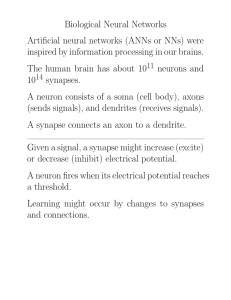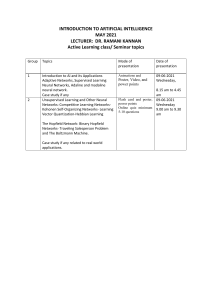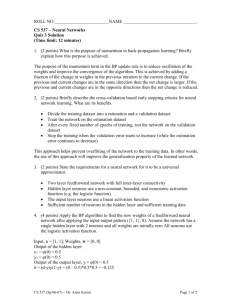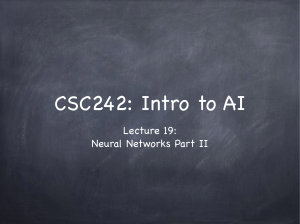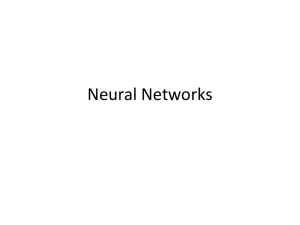Machine Learning Concepts: Logistic Regression, Naive Bayes
advertisement
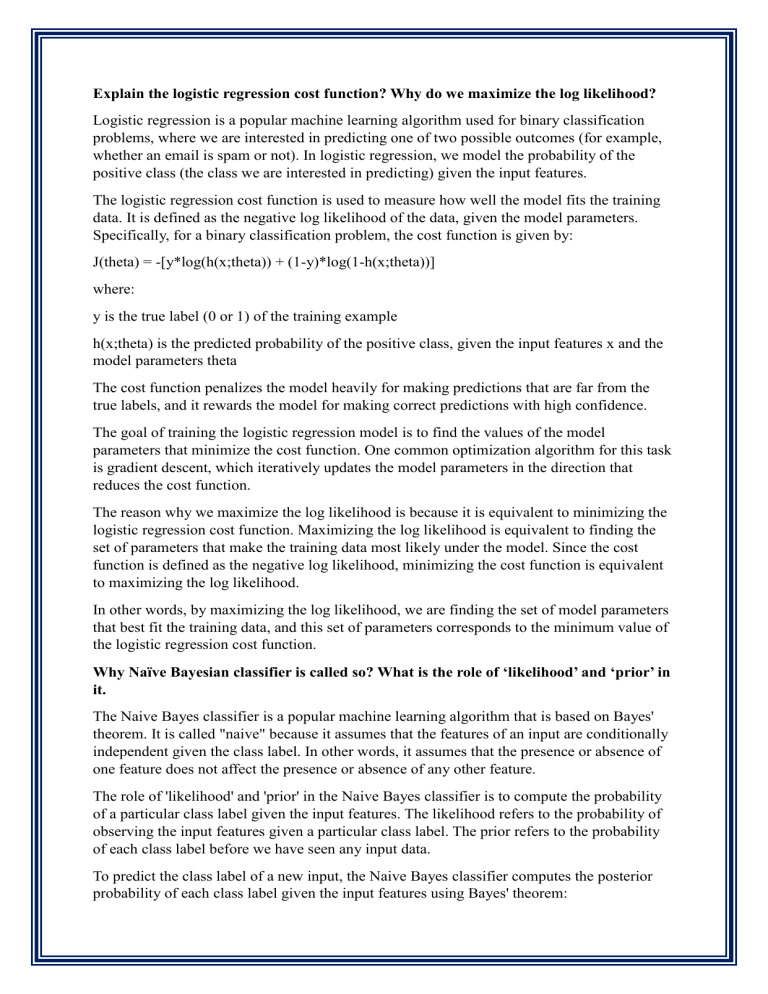
Explain the logistic regression cost function? Why do we maximize the log likelihood?
Logistic regression is a popular machine learning algorithm used for binary classification
problems, where we are interested in predicting one of two possible outcomes (for example,
whether an email is spam or not). In logistic regression, we model the probability of the
positive class (the class we are interested in predicting) given the input features.
The logistic regression cost function is used to measure how well the model fits the training
data. It is defined as the negative log likelihood of the data, given the model parameters.
Specifically, for a binary classification problem, the cost function is given by:
J(theta) = -[y*log(h(x;theta)) + (1-y)*log(1-h(x;theta))]
where:
y is the true label (0 or 1) of the training example
h(x;theta) is the predicted probability of the positive class, given the input features x and the
model parameters theta
The cost function penalizes the model heavily for making predictions that are far from the
true labels, and it rewards the model for making correct predictions with high confidence.
The goal of training the logistic regression model is to find the values of the model
parameters that minimize the cost function. One common optimization algorithm for this task
is gradient descent, which iteratively updates the model parameters in the direction that
reduces the cost function.
The reason why we maximize the log likelihood is because it is equivalent to minimizing the
logistic regression cost function. Maximizing the log likelihood is equivalent to finding the
set of parameters that make the training data most likely under the model. Since the cost
function is defined as the negative log likelihood, minimizing the cost function is equivalent
to maximizing the log likelihood.
In other words, by maximizing the log likelihood, we are finding the set of model parameters
that best fit the training data, and this set of parameters corresponds to the minimum value of
the logistic regression cost function.
Why Naïve Bayesian classifier is called so? What is the role of ‘likelihood’ and ‘prior’ in
it.
The Naive Bayes classifier is a popular machine learning algorithm that is based on Bayes'
theorem. It is called "naive" because it assumes that the features of an input are conditionally
independent given the class label. In other words, it assumes that the presence or absence of
one feature does not affect the presence or absence of any other feature.
The role of 'likelihood' and 'prior' in the Naive Bayes classifier is to compute the probability
of a particular class label given the input features. The likelihood refers to the probability of
observing the input features given a particular class label. The prior refers to the probability
of each class label before we have seen any input data.
To predict the class label of a new input, the Naive Bayes classifier computes the posterior
probability of each class label given the input features using Bayes' theorem:
P(y|x) = P(x|y) * P(y) / P(x)
where:
P(y|x) is the posterior probability of class y given input x
P(x|y) is the likelihood of observing input x given class y
P(y) is the prior probability of class y
P(x) is the probability of observing input x (this is the normalizing constant)
In the Naive Bayes classifier, the likelihood of observing the input features given a particular
class label is modeled using a probability distribution (e.g., Gaussian, Bernoulli, or
multinomial) that is appropriate for the type of input data. The prior probability of each class
label is typically estimated from the training data, either using a uniform prior or by counting
the number of instances of each class label in the training data.
Once the posterior probabilities of each class label are computed, the Naive Bayes classifier
selects the class label with the highest posterior probability as the predicted class label for the
input.
In summary, the likelihood and prior are important components of the Naive Bayes classifier
because they enable the algorithm to model the probability distribution of the input data and
make predictions based on the posterior probability of each class label given the input
features.
Difference between hard and soft computing with example
Hard computing and soft computing are two different approaches to problem-solving in
computer science and engineering.
Hard computing is an approach that relies on precise mathematical models and algorithms to
solve problems. It typically involves using well-defined rules and procedures to process data
and make decisions. Hard computing is used for problems that have a well-defined structure
and can be solved through a series of logical steps. Examples of hard computing techniques
include linear regression, decision trees, and support vector machines.
Soft computing, on the other hand, is an approach that uses approximate reasoning, fuzzy
logic, and probabilistic techniques to solve problems. It is often used for problems that are
complex, uncertain, and do not have a well-defined structure. Soft computing algorithms are
designed to mimic human reasoning and decision-making processes, and they can handle
imprecise and incomplete data. Examples of soft computing techniques include artificial
neural networks, genetic algorithms, and fuzzy logic systems.
To illustrate the difference between hard and soft computing, consider the problem of image
recognition. Hard computing techniques would involve using algorithms such as edge
detection, feature extraction, and template matching to identify objects in an image. Soft
computing techniques, on the other hand, would involve using artificial neural networks to
learn patterns in the data and make predictions based on the learned patterns. Soft computing
algorithms can handle variations in lighting, orientation, and scale, which can be difficult to
model precisely using hard computing techniques.
Another example is the problem of predicting stock prices. Hard computing techniques would
involve using mathematical models and historical data to predict future prices. Soft
computing techniques, on the other hand, would involve using genetic algorithms to optimize
trading strategies, or using fuzzy logic systems to make decisions based on uncertain market
conditions.
In summary, hard computing is used for problems that have a well-defined structure and can
be solved through a series of logical steps, while soft computing is used for problems that are
complex, uncertain, and do not have a well-defined structure.
Define delta rule? Explain significance of delta rule in defining the weights?
The delta rule, also known as the Widrow-Hoff rule, is a learning algorithm used in artificial
neural networks for supervised learning. It is used to adjust the weights of the connections
between neurons in the network based on the error between the predicted output and the
desired output.
The delta rule works by calculating the error between the predicted output and the desired
output for a given input, and then adjusting the weights of the connections between the
neurons to reduce the error. The amount of adjustment to the weights is proportional to the
error, the input value, and a learning rate parameter.
Mathematically, the delta rule can be expressed as follows:
Δw = α * (d - y) * x
where:
Δw is the change in weight of a connection
α is the learning rate, a parameter that controls the size of the weight update
d is the desired output
y is the predicted output
x is the input value
The significance of the delta rule in defining the weights is that it enables the neural network
to learn from examples and improve its performance over time. By adjusting the weights of
the connections based on the error between the predicted output and the desired output, the
neural network can gradually improve its ability to make accurate predictions.
The delta rule is a powerful and widely used learning algorithm in neural networks. It is
simple to implement and can be used with a variety of activation functions and network
architectures. However, it can be prone to getting stuck in local minima, and the choice of
learning rate parameter can affect the speed and accuracy of the learning process.
What is the difference between ADALINE and MADALINE networks?
ADALINE and MADALINE are both types of artificial neural networks used for pattern
recognition, but they have some important differences in their architectures and capabilities.
ADALINE (Adaptive Linear Neuron) is a type of single-layer neural network that uses a
linear activation function. It has one layer of input neurons that are fully connected to a single
output neuron. ADALINE is trained using the delta rule, also known as the Widrow-Hoff
rule, which adjusts the weights of the input neurons to minimize the difference between the
predicted output and the desired output. ADALINE is primarily used for linear classification
and prediction tasks.
MADALINE (Multiple ADALINE) is a type of multi-layer neural network that uses multiple
ADALINE networks in parallel. Each ADALINE network in the MADALINE architecture is
responsible for detecting a specific feature or pattern in the input data. The outputs of the
ADALINE networks are then combined to make a final decision about the class or category
of the input data. MADALINE is capable of nonlinear classification and pattern recognition
tasks and can handle more complex input data than ADALINE.
In summary, the key differences between ADALINE and MADALINE networks are:
ADALINE is a single-layer neural network, while MADALINE is a multi-layer
neural network.
ADALINE uses a linear activation function, while MADALINE can use nonlinear
activation functions.
ADALINE is primarily used for linear classification and prediction tasks, while
MADALINE is capable of nonlinear classification and pattern recognition tasks.
What is associative memory? Explain its types?
Associative memory is a type of computer memory that allows the computer to retrieve
information by content rather than by an address. It is used in artificial neural networks and
other machine learning systems to store and retrieve patterns or associations between inputs
and outputs.
There are two main types of associative memory:
Content-addressable memory (CAM): This type of associative memory stores data based on
its content rather than its location. In CAM, the data is retrieved by searching for a particular
pattern or content. This is useful when the data is stored in a distributed manner, and the
location of the data is unknown. CAM is often used in search engines and database systems.
Hopfield network: This type of associative memory is a type of recurrent neural network that
can store and retrieve patterns. It consists of a set of neurons that are fully connected to each
other. The connections between neurons are weighted, and the weights are adjusted during
the learning phase to store the patterns. During the recall phase, the network is presented with
a partial or noisy pattern, and it tries to retrieve the closest stored pattern. Hopfield networks
are often used for pattern recognition and error correction.
There are also other types of associative memory, such as bidirectional associative memory
(BAM) and neural Turing machine, which are variations of the basic associative memory
models.
In summary, associative memory is a type of computer memory that allows the computer to
retrieve information based on its content rather than its location. There are two main types of
associative memory: content-addressable memory (CAM) and Hopfield network. These
memory models are used in various applications, including pattern recognition, search
engines, and database systems.
What is exploding gradient problem while using back propagation technique?
The exploding gradient problem is a common issue that can occur during the training of
artificial neural networks using the backpropagation algorithm. Backpropagation is a
supervised learning technique that involves iteratively adjusting the weights of a neural
network based on the error between the network's predicted output and the actual output. The
weights are adjusted by calculating the gradient of the error with respect to each weight and
then updating the weights in the direction that reduces the error.
The exploding gradient problem occurs when the gradient of the error with respect to the
weights becomes too large during training. This can cause the weight updates to become
excessively large, which can result in the network becoming unstable or diverging altogether.
This is in contrast to the vanishing gradient problem, where the gradient becomes too small
and can prevent the network from learning.
The exploding gradient problem can occur in deep neural networks, which have many layers
and a large number of weights. In these networks, the gradient can become exponentially
larger as it propagates through each layer, resulting in extremely large weight updates.
There are several methods for mitigating the exploding gradient problem, including gradient
clipping, weight regularization, and using different activation functions. Gradient clipping
involves setting a maximum threshold for the gradient, so that it cannot become too large.
Weight regularization involves adding a penalty term to the loss function that discourages the
weights from becoming too large. Using activation functions that have a bounded output,
such as the sigmoid or hyperbolic tangent functions, can also help prevent the gradient from
becoming too large.
Overall, the exploding gradient problem is a common issue that can occur during the training
of artificial neural networks, particularly in deep neural networks. It can be mitigated using
various techniques, such as gradient clipping, weight regularization, and selecting appropriate
activation functions.
Explain artificial neural network based on perceptron concept wiith diagram
An artificial neural network based on the perceptron concept is a type of feedforward neural
network that is composed of multiple layers of interconnected artificial neurons. Each neuron
in the network receives inputs from the previous layer, applies a weighted sum to the inputs,
and then passes the result through an activation function to produce an output. The diagram
below shows a simple example of a perceptron-based neural network with one hidden layer.
Perceptron-based Neural Network
In the diagram, there are three layers in the network: an input layer, a hidden layer, and an
output layer. The input layer consists of three neurons that receive inputs x1, x2, and x3. The
hidden layer consists of two neurons, h1 and h2, and the output layer consists of one neuron,
y.
Each neuron in the hidden and output layers performs the following steps:
Receives inputs from the previous layer.
Applies a weighted sum to the inputs using the neuron's weights.
Passes the result through an activation function.
The weights are learned during the training process, where the network adjusts the weights to
minimize the difference between the predicted output and the actual output.
In the diagram, the weights between the input layer and the hidden layer are represented by
w1,1, w1,2, w1,3, w2,1, w2,2, and w2,3. The weights between the hidden layer and the
output layer are represented by w3,1 and w3,2. Each neuron also has a bias term that is added
to the weighted sum.
The activation function used in the hidden layer is typically a nonlinear function, such as the
sigmoid function or the hyperbolic tangent function. The activation function used in the
output layer depends on the type of problem being solved. For example, for binary
classification problems, the output neuron might use a sigmoid function to produce a value
between 0 and 1.
Overall, an artificial neural network based on the perceptron concept is a powerful machine
learning tool that can be used for a variety of tasks, including classification, regression, and
pattern recognition.
What are the components of genetic algorithm?
Genetic algorithm is a type of evolutionary algorithm that is inspired by the process of natural
selection. It is a metaheuristic optimization algorithm that can be used to find optimal
solutions to problems that involve searching through a large solution space. The components
of a genetic algorithm include:
1. Initialization: The first step in a genetic algorithm is to generate an initial population
of candidate solutions. Each candidate solution is represented as a chromosome,
which is a string of genes that encode the parameters of the solution.
2. Selection: The next step is to select a subset of the population to be used as parents for
the next generation. This is typically done using a selection method such as
tournament selection or roulette wheel selection, where the fittest individuals have a
higher probability of being selected.
3. Crossover: After selecting the parents, the genetic algorithm performs crossover,
which involves combining the genes of the selected parents to create new offspring.
Crossover can be performed using various methods, such as one-point crossover or
uniform crossover.
4. Mutation: Once the offspring have been created, the genetic algorithm performs
mutation, which involves randomly altering some of the genes in the offspring. This
introduces new genetic material into the population and helps to prevent the algorithm
from getting stuck in local optima.
5. Fitness evaluation: After generating the offspring, the genetic algorithm evaluates
their fitness using an objective function. The objective function measures how well
each candidate solution performs on the problem being solved, and is used to
determine which solutions are fitter than others.
6. Termination: The genetic algorithm continues to iterate through the selection,
crossover, mutation, and fitness evaluation steps until a stopping criterion is met. This
might be a maximum number of iterations, a target fitness value, or a time limit.
Overall, the genetic algorithm is a powerful optimization algorithm that can be used to solve
a wide range of problems. Its ability to search through a large solution space using techniques
inspired by natural selection makes it particularly effective for problems that are difficult to
solve using traditional optimization methods.
Derive the back propagation rule considering the output layer and training rule for
output unit weights
Backpropagation is a popular algorithm for training neural networks, which involves
computing the gradient of the error function with respect to the weights of the network, and
using this gradient to update the weights in a way that minimizes the error. The algorithm is
typically applied layer-by-layer, starting at the output layer and working backwards towards
the input layer. Here, we will derive the backpropagation rule for the output layer and the
training rule for output unit weights.
Assuming we have a neural network with an output layer of k neurons, and we want to
minimize the mean squared error between the network's output y and the target output t, the
error function is given by:
E = 0.5 * (t - y)^2
To minimize this error, we need to compute the gradient of the error function with respect to
the weights of the output layer, denoted by w_{ij} where i is the index of the input neuron
and j is the index of the output neuron. Using the chain rule, we have:
∂E/∂w_{ij} = ∂E/∂y_j * ∂y_j/∂z_j * ∂z_j/∂w_{ij}
were z_j is the weighted sum of inputs to neuron j, and y_j is the output of neuron j, given by:
z_j = ∑_i w_{ij} * x_i
y_j = f(z_j)
where f is the activation function used in the output layer.
Now, to compute the first term ∂E/∂y_j, we have:
∂E/∂y_j = -(t_j - y_j)
To compute the second term ∂y_j/∂z_j, we have:
∂y_j/∂z_j = f'(z_j)
where f' is the derivative of the activation function.
Finally, to compute the third term ∂z_j/∂w_{ij}, we have:
∂z_j/∂w_{ij} = x_i
Putting it all together, we get:
∂E/∂w_{ij} = -(t_j - y_j) * f'(z_j) * x_i
This is the backpropagation rule for the output layer. We can use this rule to update the
weights of the output layer using a gradient descent algorithm, where the weight update for
weight w_{ij} is given by:
Δw_{ij} = -η * ∂E/∂w_{ij}
where η is the learning rate. This gives us the training rule for the output unit weights, which
is:
w_{ij}(new) = w_{ij}(old) + Δw_{ij}
where w_{ij}(new) is the new weight value, w_{ij}(old) is the old weight value, and Δw_{ij}
is the weight update computed using the backpropagation rule.
What do you mean by learning rate of any algorithm?
The learning rate of an algorithm is a hyperparameter that determines the step size at which
the algorithm updates the parameters or weights during training. In other words, it controls
the rate or speed at which the algorithm learns from the training data. A higher learning rate
means that the algorithm takes larger steps during parameter updates, which can lead to faster
convergence but may also cause the algorithm to overshoot the optimal solution or oscillate
around it. A lower learning rate means that the algorithm takes smaller steps during parameter
updates, which can lead to slower convergence but may also result in more accurate and
stable solutions.
The learning rate is a critical hyperparameter that needs to be carefully tuned to achieve
optimal performance for a given task and dataset. If the learning rate is too high, the
algorithm may not converge to the optimal solution, or it may converge too quickly to a
suboptimal solution. If the learning rate is too low, the algorithm may take too long to
converge or get stuck in a local minimum.
Common methods for setting the learning rate include fixed learning rate, adaptive learning
rate, and batch normalization. Fixed learning rate uses a constant learning rate throughout
training, while adaptive learning rate methods adjust the learning rate based on the progress
of the training process. Batch normalization normalizes the inputs of each layer to stabilize
the network during training, which can improve the efficiency and accuracy of the algorithm.
In summary, the learning rate is a hyperparameter that determines the step size at which the
algorithm updates the parameters or weights during training, and it is critical to achieving
optimal performance and convergence.
